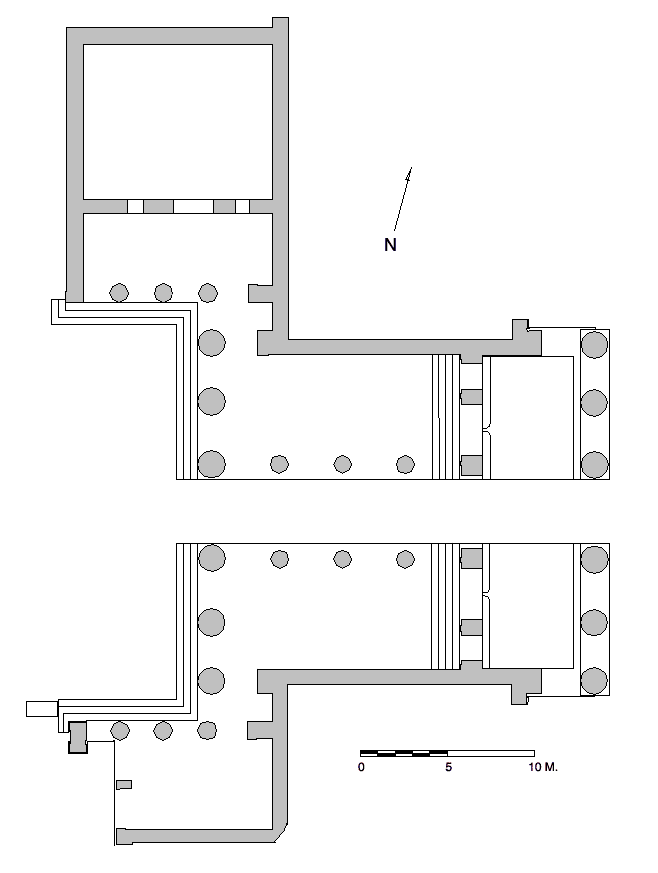The CSA Propylaea Project
Harrison Eiteljorg, II, 2013. https://doi.org/10.5284/1022574. How to cite using this DOI
Data copyright © Harrison Eiteljorg, II unless otherwise stated
This work is licensed under the ADS Terms of Use and Access.
Primary contact
Harrison
Eiteljorg, II
Center for the Study of Architecture
Box 60
Bryn Mawr
PA 19010
USA
Resource identifiers
- ADS Collection: 1591
- DOI:https://doi.org/10.5284/1022574
- How to cite using this DOI
Final Report, CSA Propylaea Project: General Information about the Propylaea
Basic Information | Plan | Beginning Bibliography
Basic information about the Propylaea
- Architect: Mnesicles
- Construction dates: 437-432 B.C., but unfinished. ("Lifting bosses" still remain in many areas, parts of walls and floors are unfinished, and preparations for never-constructed portions are clear.)
- Materials: Pentelic marble, darker Eleusinian marble, structural iron.
- Predecessors: A series of embellishments of the Bronze Age entrance, including a ramp and thin marble slabs to beautify the face of the Bronze Age fortification wall, were erected beginning around the middle of the sixth century B.C. (the ramp) and continuing through the first decades of the fifth (the beautification). They culminated in an open double-courtyard with steps separating the upper and lower levels - or a covered entrance structure - that was very heavily damaged by the Persians, repaired, and finally replaced by the Propylaea.
- Location: At the apex of the ramp leading to the Athenian Acropolis.
- Functions: The basic function of the building was as a gate structure, and the central portion is an elaborated form of the generic propylon (etymologically, that which is before the gate). The central building included a gate wall so that it truly guarded the entrance, while offering a sheltered waiting area outside the wall and therefore outside the sanctuary. The northwest wing provided an area for the display of paintings and may have been used for dining. (Often called the pinakotheka because of the paintings, the wing contained a number of paintings that have been described by Pausanias. However, paintings may not have been part of the original intent of the architect; the paintings seen by Pausanias must not have been wall paintings, since the interior wall surfaces show no signs of preparation for wall painting.) The southwest wing gave access to the Nike precinct, which lies outside the sanctuary of the Acropolis, in the sense that one need not pass through the Propylaea to gain entrance to it.
- Notable features: The structure as it stands consists of three nearly separate parts that form a U: the central building and the two west-facing wings. The two west-facing wings are not the same size, nor do they share identical façades. However, they face one another and would have appeared to be symmetrical to a viewer standing in the area between them. There were to be two larger, east-facing wings, preparations for which are evident. Neither their sizes nor their shapes can be certainly ascertained, but the plan for a southern wing on the east must have been consciously abandoned, not simply left unbuilt, since details of the construction of the southwest wing show that no southeast wing was intended at the time of the completion of the southwest wing.
The structure is Doric in style, but there are Ionic columns in the interior of the central building. Both east and west façades of the central building have six columns, but the distance between the central columns of each façade is half again as wide as the other intercolumniations. This permitted the central passageway to be wider and required an extra triglyph and metope in the frieze.
The central building consists of two porches sitting at two levels, lower on the west and higher (both at the floor level and at the roof) on the east. The west porch is much deeper than the east porch, providing the aforementioned waiting area outside the gate wall. At the top of the five-step ascent to the upper, east porch was the cross wall that regulated entrance to the Acropolis. Five doors pierced the wall, one for each of the intercolumniations of the façade. The center door was wider than the others, and, of the two doors on each side, the one closer to the building's longitudinal axis was wider.
The construction of the building seems to have been roughly from the northwest toward the southeast. The west façade, where all three parts of the building present themselves, gains cohesion from the platform on which all three parts rest. That platform consists of four steps, but the lowest of the four is, on the sides only, constructed of darker Eleusinian stone so that the height of the base there is visually reduced, reflecting the fact that the columns and the entire wing structures are shorter by roughly the same proportion.
The platform is split by the central passageway leading into the Acropolis. Though the passage is now covered by a wooden ramp for tourists, the original passage provided a route into the Acropolis without steps.
The platform does not show curvature, but the entablature of the central building does.
The central building had a pediment facing west and another facing east, though intended pedimental sculpture was never installed.
The west wings had hipped roofs on three sides; the fourth side abutted the walls separating the western wings from the never-constructed east wings.
The central building had a ceiling of marble coffer blocks, painted and having gilded stars. - A thorough description of many details, though not of the structure as a whole, may be found in the description provided by the ancient author (second century C.E.), Pausanias (I, xxii, 4 - xxiii,8).
Simplified Plan of the Propylaea

A Beginning Bibliography
- Berve, H.; Gruben, G.; and Hirmer, M. Greek Temples, Theaters, and Shrines (New York, 1963). A general look at selected Greek structures.
- Bohn, R., Die Propyläen der Akropolis zu Athen (Berlin & Stuttgart, 1882). The first thorough study of the Propylaea.
- Bundgaard, J. A., Mnesicles, A Greek Architect at Work (Copenhagen, 1957). A careful look at both the building and the implications for architectural planning. Idiosyncratic.
- Dinsmoor, W. B., The Architecture of Ancient Greece (New York, 1975 - but actually a reprint of the 1950 publication). A general book on Greek architecture; dated in many areas but valuable for the Propylaea.
- Dinsmoor, W. B., Jr., The Propylaia I: The Predecessors (Princeton, 1980). A careful study of the predecessors of the Propylaea.
- Eiteljorg, Harrison, II, The Entrance to the Acropolis Before Mnesicles (Dubuque, 1993). A careful study of the predecessors of the Propylaea, with very different conclusions from those of Dinsmoor above.
- Lawrence, A. W., Greek Architecture (Baltimore, 1973). A general book on Greek architecture.
- Robertson, D.S. Greek and Roman Architecture (Cambridge, 1969). A general book on Greek and Roman architecture. Available in paper, this may be the best place to begin for those with no knowledge of ancient architecture.
- Rhodes, R. F., Architecture and Meaning on the Athenian Acropolis (Cambridge, 1995). A modern view of the Acropolis and its monuments.
- Tanoulas, T.; Ioannidou, M.; and Moraitou, A., Study for the Restoration of the Propylaea, Volume I (Athens, 1994) Superb drawings and many careful observations.
- Tanoulas, T., The Propylaea of the Athenian Acropolis during the Middle Ages, (Athens, 1997) Two volumes. In Greek, but includes a lengthy English summary and many drawings and photographs.
- Travlos, J., Pictorial Dictionary of Ancient Athens (London, 1971). An encyclopedic approach to the monuments of Athens.
- Waele, J. A. K. E. de, The Propylaia of the Akropolis in Athens: The Project of Mnesicles (Amsterdam, 1990). More of a study of planning processes than of the building.
- The Perseus Project An electronic resource that provides quick information, but some of the information about the Propylaea was incorrect when the site was last checked. Several good photographs of the Propylaea are available through the Perseus project.
- Title: "Final Report, CSA Propylaea Project: General Information about the Propylaea
- Author: Harrison Eiteljorg, II and the staff of CSA, Box 60, Bryn Mawr, PA 19010, (e-mail: user nicke at (@) the domain csanet.org; tel.: 484-612-5862)
- Original file name: propgeninfo.html
- Revision history: Since this document is part of the Final Report, changes should not occur. Serious mistakes may be corrected; if so, clear indications of corrections will be included. First posted: November, 2002. Last updated (formatting only): July, 2012. Prepared for ADS archival storage June, 2013.
- Internet access: This document was first prepared for propylaea.csanet.org, operated by the Center for the Study of Architecture and Harrison Eiteljorg, II. It has been turned over to the Archaeology Data Service for archival preservation.
- Long-term availability: This document or its successors will be maintained for electronic access indefinitely.





